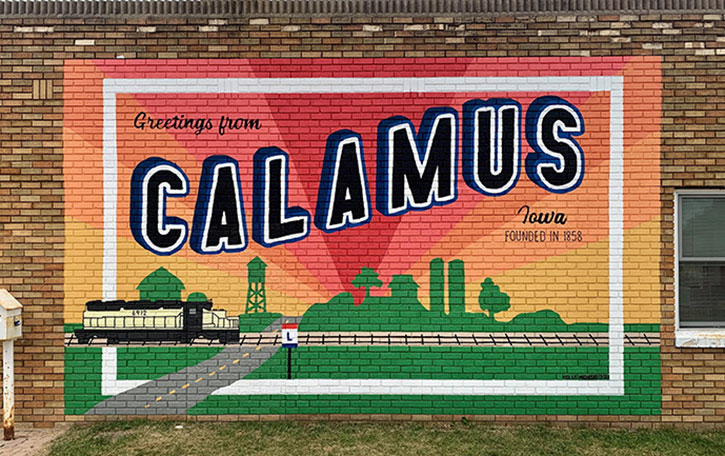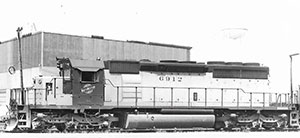History

Calamus is a small town in Clinton County, Iowa, United States located on the historical Lincoln Highway, which was the first transcontinental highway for automobiles across the U.S. Calamus is the only town in Olive Township and had a population of 439 at the 2010 census, which was an 11.4% increase from the 2000 census. Calamus was named after Calamus creek, which received its name from the great quantities of sweet flag growing in it, derived from the botanical name Acorus calamus, commonly called Sweet Flag or Calamus
Early Settlement
In July 1858 the first railroad was built west from Clinton to Clarence, Iowa. It was called the Chicago, Iowa and Nebraska Railroad, later changed to Chicago Northwestern Railroad Co.. In the same year, Joseph D. Fegan was deputized to go to the cross roads of the Stage Coach Lines and the Indian Trails at Syracuse, which had a small stove and a saloon, to establish a post office in 1858. No one could suggest a name and Mr. Fegan asked "Is there no creek or anything?" "Yes, Calamus Creek." "Then let it be Calamus." Due to the large hazardous swamps, the Post Office and railway station were moved to a more favorable location in what is now the town of Calamus.
The present day location of Calamus, a small village on the Union Pacific Railway, was platted in 1860 by R. S. Dickinson, who owned the land on the north side of the railroad, and Col. Milo Smith, who owned that on the south. James Keith opened the first store here containing a small stock of groceries and accessories, located about where the present day Faith Lutheran Church stands. In 1861, R.S. Dickinson and his son A.L. built the first general store, and opened a large and complete stock of general merchandise, and engaged in grain-buying. Two or three years later, another small store was opened by R. E. Houck.
Thomas Franklin Butterfield built the first grain elevator, to care for the grain which had previously been hauled to Davenport. In 1868, two elevators had a thriving business and there were four general stores.
The first hotel was built in the early 1860s and burned down in 1912. This building was located on the S.W. corner of 2nd and Railroad Streets and the first landlord was William Wick. Later the "Commercial Hotel" was erected on 2nd St. on the north half of Lot 6. This hotel had a livery stable and A.H. Danforth was the proprietor.
The town was replatted October 9, 1865, by Milo Smith and R.S. and Emily Dickinson.
Calamus was legally incorporated in 1876 [October 6, 1875], and E. F. Owens was elected the first Mayor. His successors have been F. Buck, in 1877, and J. C. Bowman, in 1878 and 1879. The city limits were enlarged in 1913.
Civil War
The vote in the Olive Township in 1860 was 149, and before the draft for the Civil War was ordered, 79 men volunteered into the Union Army. This was the 'banner' township of Iowa regarding enlistments in proportion to the population. The last survivor of the Civil War was Jacob W. Liebler, who died in 1941.
Schools
The first school in town was built before 1876. It was a one-room log building located on the present site of the Rose Hill Cemetery. Long benches were used as seats, long boards as desks, and a table served as the teachers desk. Miss Julia Cook (Ferren) was the first teacher. Later a white frame building was erected south of the railroad tracks. In 1902 a red brick building was erected at the same location, at the cost of $3,000. For the school year of 1909-10, the county superintendent report to the state superintendent of schools stated that Calamus had one male and two female teachers and an attendance of 78.
In 1919, it was voted to consolidate with several country school districts, and school buses were purchased. They were Model T Fords with no heat and the seats were lengthwise on both sides of the bus. The upstairs of the McCarthy building was used for the High School and the grades were housed in the old school. During the school year of 1920-21, a classroom was located in the Methodist Church and on the stage of the Auditorium. On May 17, 1921, the first graduation exercises were held in the new school, which was nearing completion, and on the same day dedication of the school was held. The next fall, school was held in the new building. The building is located at the south end of 2nd St. and was erected at a cost of $100,000. The school board members at that time were C. A. Blake, President; Hans Johnson; Wm. F. Siegmund; Jonathan Hayes, Jr. and Eli Olson. The district was known as the Calamus Consolidated School.
On May 3, 1946, marking the end of the 27 yr. period of indebtedness, the mortgage deed of the Calamus Consolidated School was burned at a ceremony in the school auditorium.
In 1950, six rooms and a large gymnasium were added at a cost of $125,000. In 1964, another six rooms were added at a cost of $196,000. The vote on the bond issue for the construction of this addition carried by 92.8%, an all-time high in the state of Iowa.
Calamus Newspapers
Calamus has not had many home printed newspapers.
The first paper that was issued in Calamus was established by H. L. Barter and was called the "Free Press." After some time, F. L. Sunderlin, later of the Delmar Journal, associated himself with Mr. Barter and the paper was continued under the name of Barter and Sunderlin. It did not have a very long existence and for various reasons it suspended publication.
Whip and Cook printed a newspaper here in the 1880s. It also had a very brief existence.
The Calamus Record was the latest newspaper venture for Calamus. It was established in 1901 by A.J. Gault and enjoyed a longer existence than the other newspapers.
Mural

Calamus was founded over 160 years ago along the intersection of the Railway, Stagecoach Lines, and the Indian Trails at Syracuse. A railroad depot was created here for the newly built railroad connecting to the American West in the 1850s. Half a century later, in the 1910s, the first transcontinental highway was being built to connect New York City to San Francisco, and it just so happens that this highway went right through Calamus! This highway is now known as U.S. Route 30, “Old Highway 30”, or the Lincoln Highway, which is now a National Scenic Byway.

The train in this mural is the Chicago & Northwest Railroad Engine 6912. On July 25th, 1976 this engine was westbound, as shown in this mural, passing through Calamus for the last time. Just two miles west of town the engine plunged into the backwaters of the Wapsipinicon River as the bridge it was crossing collapsed. On that day it took more than 15 hours to recover the body of 27-year-old Engineer, Ed Anderson, of Boone, Iowa. This mural aims to not only recognize the lost soul that day but to also highlight the community’s foundation from which we were built: agriculture and the two modes of transportation for our agricultural exports, the Railroad and the Lincoln Highway.
The railroad depot allowed for trade of agricultural and home goods to nearby settlers, primarily immigrating from Norway and Germany. The Lincoln Highway has allowed for the continued accessibility of the local community to towns near and far. This stretch of roadway has been modified several times throughout the decades but continues to be an important mode of transportation for agricultural imports and exports and for daily commuters to nearby cities for work. The community has continued to grow throughout the last 160 years and the sunrise in this mural symbolizes the bright future our children and children’s children have when growing up in this tight-knit rural Iowa community.
This “Postcard-style” mural was completed in July 2021 to showcase the city of Calamus during RAGBRAI, as more than 15,000 people came through our town. The mural was designed by Holle Michoski, a local artist, with design visioning and grant funding secured through Lance Goettsch. We greatly appreciate our support from Weber Coatings Inc. in DeWitt, the LincolnWay Community Foundation of Greater Dubuque, Alliant Energy, the Clinton County Development Association, and the countless hours of support from local volunteers.
